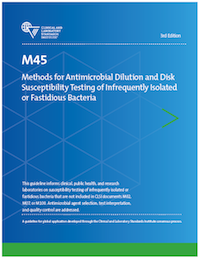Members Login

Channels
Special Offers & Promotions
CLSI Publishes a Revised Microbiology Document
The Clinical and Laboratory Standards Institute (CLSI) has published a revised document titled Methods for Antimicrobial Dilution and Disk Susceptibility Testing of Infrequently Isolated or Fastidious Bacteria (M45-Ed3).
 This guideline informs clinical, public health, and research laboratories on susceptibility testing of infrequently isolated or fastidious bacteria that are not included in CLSI documents M02, M07, or M100. Antimicrobial agent selection, test interpretation, and quality control are discussed.
This guideline informs clinical, public health, and research laboratories on susceptibility testing of infrequently isolated or fastidious bacteria that are not included in CLSI documents M02, M07, or M100. Antimicrobial agent selection, test interpretation, and quality control are discussed.
Susceptibility testing is particularly necessary in situations in which the etiological agent belongs to a bacterial species for which resistance to commonly used antimicrobial agents has been documented, or could arise. The intent of this document revision is to assist labs in determining an approach for testing that is relevant to their individual practice settings.
“M45 is an important resource for clinical microbiology laboratories, allowing interpretation of susceptibility results for organisms we test less frequently than those in M100,” states Romney Humphries, PhD, D(ABMM), M (ASCP)CM, Section Chief of Clinical Microbiology at the UCLA Medical Center in Los Angeles, California, USA. “In particular, updates to M45 for this edition, such as a test method and interpretive criteria for Aerococcus, will allow us to report susceptibilities for this organism we recover with increasing frequency from clinical specimens.”
The revised document describes the standard microdilution and agar disk diffusion methods and also includes a series of procedures designed to standardize test performance. M45 discusses organisms, such as fastidious bacteria, not described in CLSI documents M02, M07, and M100 with the goal of providing recommendations for clinical microbiology labs on how and when to determine susceptibility. It Includes taxonomic updates and several new tables for organisms more likely to be identified in labs using sequencing or matrix-assisted laser desorption/ionization time-of-flight mass spectrometry for the identification of bacteria. The document is intended for use by clinical, public health, and research labs.
Media Partners


